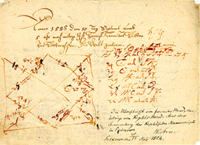![[Currents header graphic]](/homeart/currents_header.gif)
![[Currents header graphic]](/homeart/currents_header.gif)
March 1, 1999
Through a fortunate combination of sharp thinking and good luck, a 400-year-old manuscript penned by one of history's greatest astronomers was recently discovered at UCSC.

|
|
The 400-year-old manuscript by Johannes Kepler is a horoscope for an Austrian nobleman (View a
larger image or download)
|
The manuscript is a horoscope authored by 16th-century astronomer Johannes Kepler sometime in the late 1500s or early 1600s. The discovery was made by Anthony Misch, a support astronomer at Lick Observatory.
Misch was researching solar eclipse expeditions in the University Library archives when he discovered the unassuming six- by eight-inch framed paper in a drawer of miscellanea. The horoscope was annotated in German and displays three different hands, the most recent of which (dated 1864) is a note by "W. Struve," almost certainly the eminent German astronomer Wilhelm Struve, or his son.
While many others would have passed by the unassuming document, Misch stopped for a second look. This is where good fortune stepped in. Misch is not only a book collector, he speaks German. His expertise in both areas enabled him to get an immediate sense of the significance of what he held in his hand.
"It was a pretty thrilling moment," Misch remembers. "I knew right away this had potential to be a pretty spectacular discovery. As I looked the document over my hand was shaking."
A color copy of the manuscript was sent to Klaus Mecklenburg, at the firm of J. A. Stargardt in Berlin, specialists in autograph manuscripts. Mecklenberg authenticated the document without charge.
The UCSC piece documents the birth of an Austrian nobleman named Hans Hannibal Hütter von Hütterhofen, born in 1586. That information is inscribed in an ancient flowery hand at the top of the manuscript. What lies below is the work of Kepler, a complicated weaving of signs and zodiacal symbols.
Kepler, who lived from 1571 to 1630, is best known for his discovery of the laws of orbital motion. He was also a phenomenal mathematician and was responsible for major breakthroughs in telescope optics. He is considered to be, along with Copernicus and Galileo, among the most important astronomers of the modern era. "To have anything in the hand of Kepler is in and of itself valuable just because of who he is," Misch says.
According to Misch, "Kepler was required to write the occasional horoscope as part of his job as a court mathematician. It also may have been a source of extra income. Though he rejected conventional astrology (which was widely accepted at the time), his belief in the influence of the planets on the lives of men and women was genuine."
Once the initial elation of Misch's discovery wore off, the question came up of how the manuscript came to be at UCSC in the first place. Misch had found the manuscript in the observatory's Mary Lea Shane Archives, which contains mainly 19th- and 20th-century materials.
According to UCSC librarian Alan Ritch, Misch conducted further research to try and trace the trail of the precious document. "Tony's sleuthing led him to an article on Kepler in the Publications of the Astronomical Society of the Pacific (December 1, 1896). Written by Lick Observatory's first director, Edward S. Holden, much of the article is conventional biography, but one portion was not." That portion details the acquisition of the manuscript by the observatory.
The manuscript is now housed in the University Library's Special Collections unit, supervised by librarian Rita Bottoms.